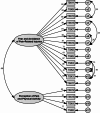Psychometric and network analysis of kinesiophobia in Iranian surgical patients
- PMID: 39516504
- PMCID: PMC11549455
- DOI: 10.1038/s41598-024-78407-1
Psychometric and network analysis of kinesiophobia in Iranian surgical patients
Abstract
Kinesiophobia, the fear of movement, can significantly impede an individual's ability to engage in daily activities. This fear often stems from past traumatic experiences or witnessing others in pain, leading to an increased fear of injury. This study aimed to evaluate the psychometric properties of the Persian version of the Tampa Scale for Kinesiophobia among Iranian post-surgery patients. A methodological study conducted in 2023 involved a sample of 400 post-surgery patients selected through convenience sampling. The translated scale underwent psychometric evaluation, including network analysis, exploratory and confirmatory factor analysis for construct validity, as well as assessments for convergent and discriminant validity. Internal consistency of the scale was also assessed. The mean age of the participants was 44.38 (SD = 13.49) years and the majority of them (77.8%) were women. Exploratory factor analysis with Promax rotation identified two factors explaining 60.28% of the variance, comprising 17 items. The final model was confirmed after necessary adjustments in confirmatory factor analysis. Both convergent and discriminant validity were established, and alpha and omega coefficients of the subscales were above 0.7. The Persian version of the Tampa Scale for Kinesiophobia showed robust psychometric properties among Iranian post-surgery patients, serving as a valuable tool for evaluating and addressing kinesiophobia in this population. These findings enhance the understanding and management of kinesiophobia within the Iranian healthcare context.
Keywords: Fear of movement; Kinesiophobia; Network analysis; Psychometrics; Reliability; Validity.
© 2024. The Author(s).
Conflict of interest statement
The authors declare no competing interests.
Figures
Similar articles
-
The Persian version of the fear of pain questionnaire mong Iranian post-surgery patients: a translation and psychometrics.BMC Psychol. 2024 Oct 10;12(1):547. doi: 10.1186/s40359-024-02040-w. BMC Psychol. 2024. PMID: 39390485 Free PMC article.
-
The persian version of the fear-avoidance beliefs questionnaire among iranian post-surgery patients: a translation and psychometrics.BMC Psychol. 2024 Jul 15;12(1):390. doi: 10.1186/s40359-024-01884-6. BMC Psychol. 2024. PMID: 39010142 Free PMC article.
-
Fear of Movement in People With CRPS: A Psychometric Evaluation of the Tampa Scale-11 for Kinesiophobia.Clin J Pain. 2024 Jan 1;40(1):26-34. doi: 10.1097/AJP.0000000000001169. Clin J Pain. 2024. PMID: 37867330
-
Sensibility and measurement properties of the Tampa Scale of Kinesiophobia to measure fear of movement in children and adults in surgical settings.Disabil Rehabil. 2023 Jul;45(14):2390-2397. doi: 10.1080/09638288.2022.2090624. Epub 2022 Jun 25. Disabil Rehabil. 2023. PMID: 35758209 Review.
-
Kinesiophobia among health professionals' interventions: a scoping review.PeerJ. 2024 Aug 22;12:e17935. doi: 10.7717/peerj.17935. eCollection 2024. PeerJ. 2024. PMID: 39184383 Free PMC article.
Cited by
-
The relationship of fear of pain, pain anxiety, and fear-avoidance beliefs with perceived stress in surgical patients with postoperative kinesiophobia.BMC Psychol. 2025 Apr 22;13(1):420. doi: 10.1186/s40359-025-02743-8. BMC Psychol. 2025. PMID: 40264201 Free PMC article.
-
Psychometric evaluation of the Farsi version of the electroconvulsive therapy related anxiety questionnaire.BMC Psychiatry. 2025 Jul 29;25(1):729. doi: 10.1186/s12888-025-07169-5. BMC Psychiatry. 2025. PMID: 40731392 Free PMC article.
-
Translation and investigation of the psychometric properties of the revised female sexual distress scale among Iranian couples.Sci Rep. 2025 Apr 12;15(1):12688. doi: 10.1038/s41598-025-95911-0. Sci Rep. 2025. PMID: 40221433 Free PMC article.
References
-
- Institute of Medicine Committee on Advancing Pain Research, Care and Education. The National Academies Collection: Reports funded by National Institutes of Health. Relieving Pain in America: A Blueprint for Transforming Prevention, Care, Education, and Research (National Academies Press (US), 2011). - PubMed
-
- Apfelbaum, J. L., Chen, C., Mehta, S. S. & Gan, T. J. Postoperative pain experience: results from a national survey suggest postoperative pain continues to be undermanaged. Anesth. Analg.97(2), 534–540 (2003). - PubMed
-
- Gan, T. J., Habib, A. S., Miller, T. E., White, W. & Apfelbaum, J. L. Incidence, patient satisfaction, and perceptions of post-surgical pain: results from a US national survey. Curr. Med. Res. Opin.30(1), 149–160 (2014). - PubMed
-
- Gerbershagen, H. J. et al. Pain intensity on the first day after surgery: a prospective cohort study comparing 179 surgical procedures. Anesthesiology118(4), 934–944 (2013). - PubMed
MeSH terms
LinkOut - more resources
Full Text Sources
Medical
Miscellaneous



